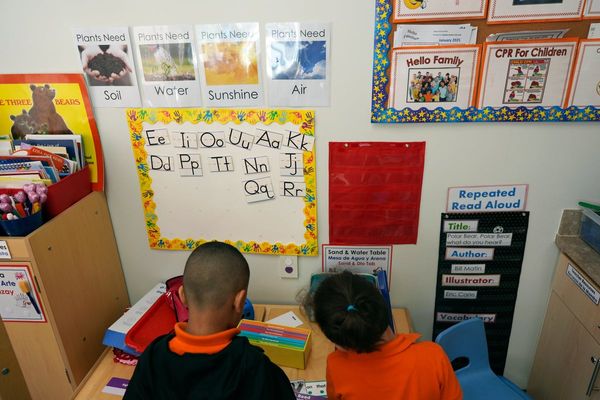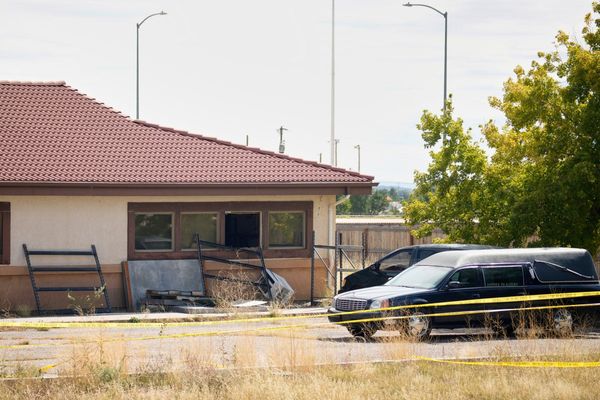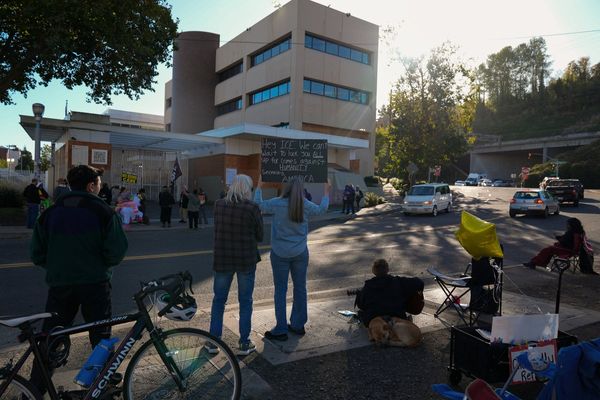/https://static.texastribune.org/media/files/44b7c156ee16e8da085304c13134c613/Uvalde%20Victims%20March%20EL%20TT%2009.jpg)
The 18-year-old who massacred 19 students and two teachers in Uvalde on May 24 had no experience with firearms before his rampage began. He targeted an elementary school with an active shooter policy that had been deemed adequate but also had a long history of doors propped open.
No one was able to stop the gunman from carrying out the deadliest school shooting in Texas history, in part because of “systemic failures and egregious poor decision making” by nearly everyone involved who was in a position of power, a new investigation into the shooting has found.
On Sunday, a Texas House committee released the most exhaustive account yet of the shooter, his planning, his attack and the fumbling response he provoked.
The 77-page report, reviewed by The Texas Tribune, provides a damning portrayal of a family unable to recognize warning signs, a school district that had strayed from strict adherence to its safety plan and a police response that disregarded its own active shooter training.
It explains how the gunman, who investigators believe had never fired a gun before May 24, was able to stockpile military-style rifles, accessories and ammunition without arousing suspicion from authorities, then enter a supposedly secure school unimpeded and indiscriminately kill children and adults.
In total, 376 law enforcement officers — a force larger than the garrison that defended the Alamo — descended upon the school in a chaotic, uncoordinated scene that lasted for more than an hour. The group was devoid of clear leadership, basic communications and sufficient urgency to take down the gunman, the report says.
Reference
A Texas House committee's report on the Robb Elementary School shooting in Uvalde.Notably, the investigation is the first so far to criticize the inaction of state and federal law enforcement, while other reports and public accounts by officials have placed the blame squarely on Uvalde Consolidated Independent School District police Chief Pete Arredondo for his role as incident commander and other local police who were among the first to arrive.
The report also reveals for the first time that the overwhelming majority of responders were federal and state law enforcement: 149 were U.S. Border Patrol, and 91 were state police — whose responsibilities include responding to “mass attacks in public places.” There were 25 Uvalde police officers and 16 sheriff’s deputies. Arredondo’s school police force accounted for five of the officers on the scene. The rest of the force was made up of neighboring county law enforcement, U.S. marshals and federal Drug Enforcement Administration officers.
[What we know, minute by minute, about how the Uvalde shooting and police response unfolded]
The investigators said that in the absence of a strong incident commander, another officer could have — and should have — stepped up to the task.
“These local officials were not the only ones expected to supply the leadership needed during this tragedy,” the report said. “Hundreds of responders from numerous law enforcement agencies — many of whom were better trained and better equipped than the school district police — quickly arrived on the scene.”
The other responders “could have helped to address the unfolding chaos.”
The three committee members — Rep. Dustin Burrows, R-Lubbock; Rep. Joe Moody, D-El Paso; and former state Supreme Court Justice Eva Guzman — said they sought to create a comprehensive account the Legislature can use to craft policies aimed at preventing future massacres. The trio also sought to present an accurate narrative to the public, in contrast to several conflicting and retracted accounts provided by other officials, including the governor and state police, in the seven weeks since the tragedy that have undermined residents’ trust in the ongoing investigations.
They dedicated the document to the 21 people killed in the shooting and first unveiled their findings during a private meeting with Uvalde residents on Sunday.
“The Committee issues this interim report now, believing the victims, their families, and the entire Uvalde community have already waited too long for answers and transparency,” the report reads.
Law enforcement failures
The failure of police to quickly subdue the shooter has faced widespread public condemnation and criticism from fellow law enforcement officials. At its core, the committee report echoes criticisms made previously by police tactics experts: that instead of following the doctrine developed after the 1999 Columbine High School massacre, which dictates that officers immediately confront active shooters, police at Robb Elementary retreated after coming under fire and then waited for backup.
“They failed to prioritize saving the lives of innocent victims over their own safety,” the committee said in its report.
The report lists myriad law enforcement mistakes, which expanded far beyond any single commander or agency. They stemmed not from a lack of manpower, but from an absence of leadership and effective communications.
In interviews conducted or obtained by the committee, police officers said they assumed Arredondo was in command or did not know who was in charge. Several described the scene as “chaos” or a “cluster.”
The report listed several ways that an effective incident commander outside the school might have helped: The commander might have noticed that radios weren’t working well and found a better way to communicate. They might have found a master key to the school faster to get inside the classroom where the shooter was barricaded — or suggested checking to make sure the door was locked. Or they might have urged officers to find another way to get inside the classroom.
But Arredondo told The Texas Tribune in June that he did not consider himself the incident commander after he was one of the first officers to arrive inside the school. He said he assumed another officer outside would fill that role.
The committee did not find this argument persuasive. It cited the school district’s active shooter response plan, co-authored by Arredondo, which states the chief will “become the person in control of the efforts of all law enforcement and first responders that arrive at the scene.” The school district last month placed him on administrative leave.
But blame for the flawed police response extends far beyond the school district police chief of a six-officer department, the report concludes.
The report criticized other officers and law enforcement agencies, many of them better trained, for failing to fill the leadership vacuum left by Arredondo’s inaction.
“In this crisis, no responder seized the initiative to establish an incident command post,” the committee wrote. “Despite an obvious atmosphere of chaos, the ranking officers of other responding agencies did not approach the Uvalde CISD chief of police or anyone else perceived to be in command to point out the lack of and need for a command post, or to offer that specific assistance.”
In testimony to a Senate committee June 21, Department of Public Safety Commissioner Steve McCraw said some officers on scene observed that Arredondo was not acting like an incident commander.
McCraw previously dismissed the idea that his state troopers could or should have stepped in to take control from Arredondo.
“Let’s say a DPS captain shows up in a situation, decides he’s going to exercise control,” McCraw told senators last month. “Well, first of all, he doesn’t have the information. And you know what? He may not be as sharp as the on-scene commander that’s there … so I’m reluctant to encourage or even think of any situation where you’d want some level of hierarchy where a larger police department gets to come in and take over.”
Yet when pressed by Sen. Roland Gutierrez, a Democrat whose district includes Uvalde, McCraw conceded that confronting an active shooter is more important than deferring to an officer who, according to protocol, is the rightful incident commander.
DPS officials did not respond to requests for comment Sunday.
Ultimately, the report said Border Patrol agents decided they would breach the classroom without seeking permission from Arredondo. That team killed the gunman at 12:51 p.m., ending the standoff.
Despite the collective failure of police to act decisively, the committee uncovered individual instances in which officers acted boldly without instruction.
When officers were driven back by gunfire just after entering the school, Uvalde Police Department Lt. Javier Martinez attempted to confront the shooter again. He advanced up the hallway in “an evident desire to maintain momentum and to ‘stop the killing.’” No officers followed him, and he stopped. Several law enforcement officers told the committee that they believed if others had followed him as backup, he might have made it to the classroom and engaged with the shooter.
DPS Special Agent Luke Williams disregarded a request that he assist in securing a perimeter outside and instead entered the building to help clear rooms. He found a student hiding in a boys bathroom stall with his legs up so he couldn’t be seen. The boy refused to come out until Williams proved he was a police officer, which he did by showing his badge beneath the door of the stall.
Williams then encountered a group of officers clustered at the end of the hallway where the shooter was and overheard someone ask, “Y’all don’t know if there’s kids in there?”
“If there’s kids in there, we need to go in there,” Williams said at 11:56 a.m., according to footage captured by his body camera.
An officer in the hallway responded to Williams that “whoever was in charge would figure that out,” the report said.
Inadequate school safety
Robb Elementary School, on its face, had all the pieces in place to slow an intruder. The school is encircled by a 5-foot fence. It has an emergency management alert system and school policies for faculty and staff to keep exterior and interior doors locked at all times.
But a culture of complacency weakened these safeguards.
Multiple witnesses told the committee that employees often left doors unlocked, while teachers would use rocks, wedges and magnets to prop open interior and exterior doors. This was partly because of a shortage of keys.
“In fact, the school actually suggested circumventing the locks as a solution for the convenience of substitute teachers and others who lacked their own keys,” the report said.
In March, the teacher in Room 111, through which investigators believe the shooter entered during the massacre, reported to school administrators that his classroom door “was not always locking.” The head custodian testified he never heard of any problems with that door, and maintenance records during the school year do not contain any work orders for it. The teacher, Arnulfo Reyes, was shot twice in the shooting but survived.
Ultimately, the shooter was able to easily scale the fence and enter the school through a series of unlocked doors.
“Had school personnel locked the doors as the school’s policy required, that could have slowed his progress for a few precious minutes — long enough to receive alerts, hide children, and lock doors,” the report found.
The question of locked doors came into play again when law enforcement arrived and assumed they couldn’t break down the doors of the classroom to reach the gunman.
They would fumble for several minutes in search of a key, and other equipment to break down the door, that is now believed to have been unlocked the entire time.
The search for the unnecessary key was complicated by the fact that the school, which first opened in 1955, had different sets of master keys for different doors. Lt. Mike Hernandez of the district police department said he typically carried 50 keys to various campus buildings, though sometimes he had to jiggle them to turn locks. On other occasions, staff changed locks without his knowledge. During the shooting, other officers attempted without success to use Hernandez’s set to find a suitable master key for the wing of the school where the shooter was.
Additionally, some faculty and staff did not initially take the intruder alert seriously because they were desensitized to the alert system, which often was triggered by frequent immigration-related police pursuits.
Uvalde is about 50 miles east of the border with Mexico and sits at the intersection of major highways from the border cities of Del Rio and Eagle Pass. Police described a recent increase in “bailouts,” when officers chase a vehicle containing suspected undocumented migrants, who then purposely crash and scatter to avoid apprehension. School district officials told the committee there had been 47 “secure” or “lockdown” events since February 2022. Around 90% of those had been because of bailouts.
There has never been an incident of school violence related to the bailouts.
“The series of bailout-related alerts led teachers and administrators to respond to all alerts with less urgency—when they heard the sound of an alert, many assumed that it was another bailout,” the report states.
Even when there were alerts, it wasn’t certain that everyone would receive them. The emergency management alert system operates by sending out warnings online to teachers and faculty — and many access it through a smartphone app.
But not all teachers received the alert about the gunman immediately, thanks in part to a poor wireless internet signal that made it difficult to send out the alert and the fact that many teachers didn’t have their phones or had them off at the moment they received it.
Principal Mandy Gutierrez never attempted to communicate the lockdown over the school’s intercom system.
Missed warnings signs
The gunman, Salvador Ramos, displayed signs he was unstable and possibly planning a violent attack, yet none of these warning signs reached authorities.
A year before the massacre, he had earned the nickname “school shooter” on social media platforms because of violent threats he would make against other users. With few, if any, friends and a strained relationship with his parents, the report describes him as a high school dropout and social outcast who eventually concluded that spectacular violence could bring him “notoriety and fame.”
Online, the committee found, he became interested in gore and violent sex, sometimes sharing videos and images of suicides and beheadings. His internet search history suggested he questioned whether he was a sociopath.
In real life, he was fired from two fast-food jobs. At Whataburger, he harassed a female employee and at Wendy’s he would not talk with any co-workers, except one occasion when he attempted to start a conversation about guns.
In the final months of his life, he was determined to acquire guns, a desire the report says family and friends were aware of. Because he lived with his grandmother and had no expenses, he was able to use his money for this effort.
While he was still 17, the shooter asked at least two people to purchase guns for him, but they refused. Instead, he focused on purchasing accessories, including a gun sight, rifle sling and body armor carrier. He turned 18, the legal age to buy guns in Texas, on May 16. Over the course of the next week, he spent more than $3,000 on two AR-15-style rifles from an online retailer, which shipped the weapons to a Uvalde gun shop.
Because he had no license and did not know how to drive, an uncle transported him to the gun store twice. His uncle said the first time he didn’t know he was going to pick up a rifle, since the store is also a popular restaurant in town and his nephew said he was hungry. But he returned with a narrow box and no food.
The owner of the gun store, Oasis Outback, remembered him and described him to investigators as an “average customer with no ‘red flags.’” Other store patrons told the FBI they thought he was “very nervous looking” and “appeared odd and looked like one of those school shooters.”
The report details no attempt by anyone who interacted with the gunman to alert authorities about his troubling behavior.
Undermining trust
In the days after the shooting, state officials unnecessarily undermined public trust in the ongoing investigations by making false statements about what had happened, the report states. The day after the massacre, a Uvalde Police Department lieutenant tasked with briefing Gov. Greg Abbott and other state leaders fainted just before the meeting began.
DPS Regional Director Victor Escalon took his place, relaying the secondhand accounts of police, as he had arrived at the school minutes before the shooting ended. Some of this information was inaccurate, which the committee said was the reason Abbott, in a news conference immediately following the briefing, presented a “false narrative” that the shooting lasted as few as 40 minutes thanks to “officers who rapidly devised a plan, stacked up and neutralized the attacker.”
Abbott also said that the gunman had been confronted by a school resource officer before entering the school. At a news conference the following day, a DPS official said the exterior door through which the gunman entered had been propped open. Both statements were false.
The committee criticized state officials for misleading the public.
“A complete and thorough investigation can take months or even years to confirm every detail, especially when this many law enforcement officers are involved,” the report states. “However, one would expect law enforcement during a briefing would be very careful to state what facts are verifiable, and which ones are not.”
Abbott’s office did not respond to a request for comment Sunday.
The committee also refutes a significant revelation included in a report published last week by the Advanced Law Enforcement Rapid Response Training (ALERRT) Center at Texas State University. That report stated that a Uvalde Police Department officer with a rifle had an opportunity to shoot the gunman before he entered the school. However, when he asked a supervisor for permission to fire, he never received a response and the gunman slipped into the school.
The committee noted that the ALERRT staff conducted no investigation on their own and relied entirely on information supplied by the Department of Public Safety. The committee concluded that the person the Uvalde officer saw was a coach who was ushering children inside, and found no evidence that any law enforcement personnel had a chance to engage the gunman outside the school.
The disastrous police response at Robb Elementary has set this mass shooting apart from so many that have become a regular occurrence in American life. It has renewed the debate over the role of police and cast doubt on the theory embraced by many Second Amendment advocates that good guys with guns are the best defense against active shooters.
Yet the report concludes with a somber finding: Because the gunman fired the majority of his rounds before police arrived inside the school, about 100 in the space of three minutes, whether the death toll would have been lower had police breached the classrooms immediately is unknown.
Most of the victims died quickly, torn apart by bullets designed for battlefields, and it is unclear whether a flawless police response would have saved any lives. But the report suggests that stopping the gunman sooner could have made a difference.
“Given the information known about victims who survived through the time of the breach and who later died on the way to the hospital,” the committee wrote, “it is plausible that some victims could have survived if they had not had to wait 73 additional minutes for rescue.”
Uriel Garcia contributed to this story.
Correction, July 17, 2022: The House committee report misstated the name of a federal agency and a previous version of this story repeated the error. It is the Drug Enforcement Administration, not the Drug Enforcement Agency.







